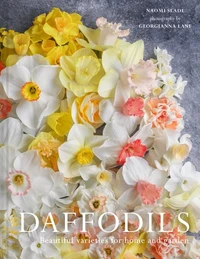Ranunculus offers advice on how to care for and propagate these colourful cultivated members of the buttercup family. Naomi Slade explores a wide range of ranunculus species and cultivars, all beautifully photographed by Georgianna Lane in their technicolour glory from palest pink to deep burgundy via white, orange, red and yellow.
Pert as a rosebud and blousy as a dahlia, Ranunculus asiaticus is the flower of the moment.
From ancestors that grew wild in the eastern Mediterranean, these Persian buttercups have been bred and selected to create fully double blooms; with layers of delicate, tissue-paper petals sculpted to perfection and available in a range of colours to suit any occasion.
The buttercup family is a huge and diverse one, however, and the genus Ranunculus contains not just these exotic florists' darlings, but a whole range of their close relatives too.
Some are familiar: when fields and lawns are sprinkled with golden meadow buttercups, we can be sure that spring has arrived. Yet there are also rare mountain blooms, perched on crags and fed by the melting snow, and forms of Ranunculus that thrive in pond margins or flourish in fast-flowing streams.
Naomi Slade explores the world of buttercups, from their wild origins to their most successfully cultivated and most popular forms.
Some are easy to grow, some less so, and this book offers tips and advice to help the reader embrace not just those near-wild forms that lend themselves to naturalistic planting schemes, and the exquisite, collectible alpines, but also the brilliant, desirable, Persian buttercups that are so perfect for cutting and arranging.
Ranunculus offers advice on how to care for and propagate these colourful cultivated members of the buttercup family. Naomi Slade explores a wide range of ranunculus species and cultivars, all beautifully photographed by Georgianna Lane in their technicolour glory from palest pink to deep burgundy via white, orange, red and yellow.
Pert as a rosebud and blousy as a dahlia, Ranunculus asiaticus is the flower of the moment.
From ancestors that grew wild in the eastern Mediterranean, these Persian buttercups have been bred and selected to create fully double blooms; with layers of delicate, tissue-paper petals sculpted to perfection and available in a range of colours to suit any occasion.
The buttercup family is a huge and diverse one, however, and the genus Ranunculus contains not just these exotic florists' darlings, but a whole range of their close relatives too.
Some are familiar: when fields and lawns are sprinkled with golden meadow buttercups, we can be sure that spring has arrived. Yet there are also rare mountain blooms, perched on crags and fed by the melting snow, and forms of Ranunculus that thrive in pond margins or flourish in fast-flowing streams.
Naomi Slade explores the world of buttercups, from their wild origins to their most successfully cultivated and most popular forms.
Some are easy to grow, some less so, and this book offers tips and advice to help the reader embrace not just those near-wild forms that lend themselves to naturalistic planting schemes, and the exquisite, collectible alpines, but also the brilliant, desirable, Persian buttercups that are so perfect for cutting and arranging.

 , qui est-ce ?
, qui est-ce ?